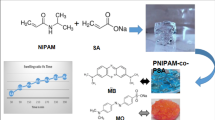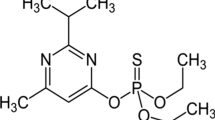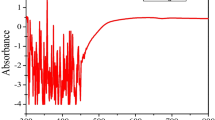Abstract
As a novel adsorbent, an opioid silver-morphine-functionalized polypropylene was synthesized through a one-pot reaction at room temperature and successfully used for the simple one-pot photocatalytic degradation catalyst of methyl orange removal from wastewater. UV spectral analysis reveals a special reference to the excitation of surface plasmon resonance as the main characteristic of the polymer-Ag nanocomposite in toluene solution peak at 420 nm in AgPP-mrp catalyst. The 1H NMR spectrum showed no sign of Ag NP peaks revealing small size distribution in the channels of morphine-functionalized polypropylene polymer. The morphology of silver nanoparticle-doped polymer through scanning electron microscopy (SEM–EDX) reveals PP-mrp with continuous matrix and Ag NPs (0.87 wt%). Furthermore, photocatalytic degradation of methyl orange was investigated on AgPP-mrp catalyst spectrophotometrically under solar irradiation in waste effluent, demonstrating high degradation efficiency. According to experimental findings, silver nanoparticles (AgPP-mrp) achieved high degradation capacities of 139 mg/g equivalent to 97.4% of photodegradation in a little period of time (35 min), as associated with previously stated materials and follow pseudo-second-order kinetic degradation tail of a high regression coefficient (R2 = 0.992). The suggested techniques offer a linear reaction for MO over the pH range of 1.5 to 5 and a degradation temperature of 25 to 60 °C. Central composite design and response surface methodology statistics recommend pH of the reaction medium and time as important variables for methyl orange degradation on AgPP-mrp photocatalytic. AgPP-mrp on the photocatalytic phenomenon based on heterojunction catalytic design producing electron holes (e-), as well as superoxides for the successful degradation of methyl orange.
Graphical Abstract













Similar content being viewed by others
Data availability
Not applicable.
References
Acar M, Çoban S, Hazer B (2013) Novel water soluble soya oil polymer from oxidized soya oil polymer and diethanol amine. J Macromol Sci Part A 50(3):287–296
Acik G (2021) Fabrication of polypropylene fibers possessing quaternized ammonium salt based on the combination of CuAAC click chemistry and electrospinning. React Funct Polym 168:105035
Al-Zaban MI, Mahmoud MA, AlHarbi MA (2021) Catalytic degradation of methylene blue using silver nanoparticles synthesized by honey. Saudi J Biol Sci 28(3):2007–2013
Ambaye TG, Vaccari M, Prasad S, van Hullebusch ED, Rtimi S (2022) Preparation and applications of chitosan and cellulose composite materials. J Environ Manage 301:113850
Berber E, Horzum N, Hazer B, Demir MM (2016) Solution electrospinning of polypropylene-based fibers and their application in catalysis. Fibers Polymers 17:760–768
Can A, Palanti S, Sivrikaya H, Hazer B, Stefanı F (2019) Physical, biological and chemical characterisation of wood treated with silver nanoparticles. Cellulose 26:5075–5084
Chen L, Zhang W, Wang J, Li X, Li Y, Hu X, Zhao L, Wu Y, He Y (2021) High piezo/photocatalytic efficiency of Ag/Bi5O7I nanocomposite using mechanical and solar energy for N2 fixation and methyl orange degradation. Green EnergyEnviron
Cheng G, Simon PF, Hartenstein M, Müller AH (2000) Synthesis of hyperbranched poly (tert-butyl acrylate) by self-condensing atom transfer radical polymerization of a macroinimer. Macromol Rapid Commun 21(12):846–852
Cheng S (2003) Heavy metal pollution in China: origin, pattern and control. Environ Sci Pollut Res 10:192–198
Crini G (2005) Recent developments in polysaccharide-based materials used as adsorbents in wastewater treatment. Prog Polym Sci 30(1):38–70
Dai K, Chen H, Peng T, Ke D, Yi H (2007) Photocatalytic degradation of methyl orange in aqueous suspension of mesoporous titania nanoparticles. Chemosphere 69(9):1361–1367
Didaskalou P, Kafetzi M, Pispas S (2022) Cationic polyelectrolytes containing perfluorinated groups: synthesis and self-assembly properties in aqueous solutions. Macromol 2(2):194–210
Ekalu A, Habila JD (2020) Flavonoids: isolation, characterization, and health benefits. Beni-Suef Univ J Basic Appl Sci 9(1):1–14
Elamawi RM, Al-Harbi RE, Hendi AA (2018) Biosynthesis and characterization of silver nanoparticles using Trichoderma longibrachiatum and their effect on phytopathogenic fungi. Egypt J Biol Pest Control 28(1):1–11
Erdem Ç, Isık T, Horzum N, Hazer B, Demir MM (2022) Electrospinning of fatty acid‐based and metal incorporated polymers for the fabrication of eco‐friendly fibers. Macromol Chem Phys :2100438
Eroğlu MS, Hazer B, Güven O, Baysal BNM (1996) Preparation and thermal characterization of block copolymers by macroazonitriles having glycidyl azide and epichlorohydrin moieties. J Appl Polymer Sci 60(12):2141–2147
Fadeel B, Farcal L, Hardy B, Vázquez-Campos S, Hristozov D, Marcomini A, Lynch I, Valsami-Jones E, Alenius H, Savolainen K (2018) Advanced tools for the safety assessment of nanomaterials. Nat Nanotechnol 13(7):537–543
Fan Q, Wang T, Fan W, Xu L (2022) Recyclable visible-light photocatalytic composite materials based on tubular Au/TiO2/SiO2 ternary nanocomposites for removal of organic pollutants from water. Compos Commun 32:101154
Fei X, Jia M, Du X, Yang Y, Zhang R, Shao Z, Zhao X, Chen X (2013) Green synthesis of silk fibroin-silver nanoparticle composites with effective antibacterial and biofilm-disrupting properties. Biomacromol 14(12):4483–4488
Gauthier M (2007) Arborescent polymers and other dendrigraft polymers: a journey into structural diversity. J Polym Sci Part A: Polym Chem 45(17):3803–3810
Ghalei S, Handa H (2022) A review on antibacterial silk fibroin-based biomaterials: current state and prospects. Mater Today Chem 23:100673
Gopinath K, Kumaraguru S, Bhakyaraj K, Mohan S, Venkatesh KS, Esakkirajan M, Kaleeswarran P, Alharbi NS, Kadaikunnan S, Govindarajan M (2016) Green synthesis of silver, gold and silver/gold bimetallic nanoparticles using the Gloriosa superba leaf extract and their antibacterial and antibiofilm activities. Microb Pathog 101:1–11
Han SW, Kim Y, Kim K (1998) Dodecanethiol-derivatized Au/Ag bimetallic nanoparticles: TEM, UV/VIS, XPS, and FTIR analysis. J Colloid Interface Sci 208(1):272–278
Haruna A, Abdulkadir I, Idris S (2020) Photocatalytic activity and doping effects of BiFeO3 nanoparticles in model organic dyes. Heliyon 6(1):e03237
Haruna A, Chong F-K, Ho Y-C, Merican ZMA (2022) Preparation and modification methods of defective titanium dioxide-based nanoparticles for photocatalytic wastewater treatment—a comprehensive review. Environ Sci Pollut Res 29(47):70706–70745
Hazer B (1987) Polymerization of vinyl monomers by a new oligoperoxide: oligo (adipoyl-5-peroxy-2, 5-dimethyl n-hexyl peroxide). J Polym Sci Part A: Polym Chem 25(12):3349–3354
Hazer B, Kalaycı ÖA (2017) High fluorescence emission silver nano particles coated with poly (styrene-g-soybean oil) graft copolymers: antibacterial activity and polymerization kinetics. Mater Sci Eng C 74:259–269
Hazer B, Steinbüchel A (2007) Increased diversification of polyhydroxyalkanoates by modification reactions for industrial and medical applications. Appl Microbiol Biotechnol 74(1):1–12
Hazer DB, Kılıçay E, Hazer B (2012a) Poly (3-hydroxyalkanoate) s: diversification and biomedical applications: a state of the art review. Mater Sci Eng C 32(4):637–647
Hazer DB, Mut M, Dinçer N, Saribas Z, Hazer B, Özgen T (2012b) The efficacy of silver-embedded polypropylene-grafted polyethylene glycol-coated ventricular catheters on prevention of shunt catheter infection in rats. Child’s Nervous System 28:839–846
Hazer DB, Sakar M, Dere Y, Altinkanat G, Ziyal MI, Hazer B (2016) Antimicrobial effect of polymer-based silver nanoparticle coated pedicle screws: experimental research on biofilm inhibition in rabbits. Spine 41(6):E323–E329
Ismail HK, Ali LIA, Alesary HF, Nile BK, Barton S (2022) Synthesis of a poly (p-aminophenol)/starch/graphene oxide ternary nanocomposite for removal of methylene blue dye from aqueous solution. J Polym Res 29(5):159
Kamigaito M, Ando T, Sawamoto M (2001) Metal-catalyzed living radical polymerization. Chem Rev 101(12):3689–3746
Kuperkar K, Patel D, Atanase LI, Bahadur P (2022) Amphiphilic block copolymers: their structures, and self-assembly to polymeric micelles and polymersomes as drug delivery vehicles. Polymers 14(21):4702
Li J, Yang Z-L, Ding T, Song Y-J, Li H-C, Li D-Q, Chen S, Xu F (2022) The role of surface functional groups of pectin and pectin-based materials on the adsorption of heavy metal ions and dyes. Carbohyd Polym 276:118789
Li M, Guan R, Li J, Zhao Z, Zhang J, Qi Y, Zhai H, Wang L (2020) Photocatalytic performance and mechanism research of Ag/HSTiO2 on degradation of methyl orange. ACS Omega 5(34):21451–21457
Li Y, Li X, Li J, Yin J (2006) Photocatalytic degradation of methyl orange by TiO2-coated activated carbon and kinetic study. Water Res 40(6):1119–1126
Liu S, Sun H, Liu S, Wang S (2013) Graphene facilitated visible light photodegradation of methylene blue over titanium dioxide photocatalysts. Chem Eng J 214:298–303
Ma H, Wang B, Luo X (2007) Studies on degradation of methyl orange wastewater by combined electrochemical process. J Hazard Mater 149(2):492–498
Mandal S, Venkatramani J (2023) A review of plant-based natural dyes in leather application with a special focus on color fastness characteristics. Environ Sci Pollut Res :1–9
Markowska K, Grudniak A, Wolska K (2013) Silver nanoparticles as an alternative strategy against bacterial biofilms. Acta Biochim Pol 60(4):523–530
Matthes R, Frey H (2022) Polyethers based on short-chain alkyl glycidyl ethers: thermoresponsive and highly biocompatible materials. Biomacromol 23(6):2219–2235
Moad G (2011) Chemical modification of starch by reactive extrusion. Prog Polym Sci 36(2):218–237
Nguyen TD, Nguyen QD, Nguyen TT (2014) Preparation of platinum nanoparticles in liquids by laser ablation method. Adv Nat Sci: Nanosci Nanotechnol 5(3):035011
Noor A, Ullah R, Tuzen M, Hassan A, Ullah S (2023) Silver-coated activated carbon nanocomposite by Moringa oleifera for dye removal by multivariate optimization approach. Biomass Convers Biorefin :1–13
Rao JP, Geckeler KE (2011) Polymer nanoparticles: preparation techniques and size-control parameters. Prog Polym Sci 36(7):887–913
Ristig S, Kozlova D, Meyer-Zaika W, Epple M (2014) An easy synthesis of autofluorescent alloyed silver–gold nanoparticles. J Mater Chem B 2(45):7887–7895
Ruzette A-V, Leibler L (2005) Block copolymers in tomorrow’s plastics. Nat Mater 4(1):19–31
Ruzette A-V, Tence-Girault S, Leibler L, Chauvin F, Bertin D, Guerret O, Gerard P (2006) Molecular disorder and mesoscopic order in polydisperse acrylic block copolymers prepared by controlled radical polymerization. Macromolecules 39(17):5804–5814
Saleh TA, Tuzen M, Sarı A (2021) Evaluation of poly (ethylene diamine-trimesoyl chloride)-modified diatomite as efficient adsorbent for removal of rhodamine B from wastewater samples. Environ Sci Pollut Res 28(39):55655–55666
Saravanan R, Manoj D, Qin J, Naushad M, Gracia F, Lee AF, Khan MM, Gracia-Pinilla M (2018) Mechanothermal synthesis of Ag/TiO2 for photocatalytic methyl orange degradation and hydrogen production. Process Saf Environ Prot 120:339–347
Savolainen K, Alenius H, Norppa H, Pylkkänen L, Tuomi T, Kasper G (2010) Risk assessment of engineered nanomaterials and nanotechnologies—a review. Toxicology 269(2–3):92–104
Steube M, Johann T, Barent RD, Mueller AH, Frey H (2022) Rational design of tapered multiblock copolymers for thermoplastic elastomers. Prog Polym Sci 124:101488
Ullah R, Tuzen M (2022) Interactions of Ni/ZnO with Alumina Support and Their Influence on Deep Reactive Adsorption Desulfurization. J Mol Liq :120082
Ullah R, Tuzen M, Ullah S, Haroon M, Khattak R, Saleh TA (2022) Acidic sites enhanced ultra-deep desulfurization performance of novel NiZnO-based mixed oxides mesoporous adsorbents. Surf Interfaces :102566
Ullah R, Zhang Z, Bai P, Wu P, Han D, Etim U, Yan Z (2016). One-pot Cation-anion Double Hydrolysis Derived Ni/ZnO-Al2O3 absorbent for Reactive Adsorption Desulfurization. Ind Eng Chem Res
Veerapandian M, Lim SK, Nam HM, Kuppannan G, Yun KS (2010) Glucosamine-functionalized silver glyconanoparticles: characterization and antibacterial activity. Anal Bioanal Chem 398:867–876
Wang C, Shi Z-H, Peng L, He W-M, Li B-L, Li K-Z (2017) Preparation of carbon foam-loaded nano-TiO2 photocatalyst and its degradation on methyl orange. Surfaces and Interfaces 7:116–124
Wang J, Jia Z, Liang S, Qin P, Zhang W, Wang W, Sercombe T, Zhang L (2018) Fe73. 5Si13. 5B9Cu1Nb3 metallic glass: rapid activation of peroxymonosulfate towards ultrafast Eosin Y degradation. Mater Des 140:73–84
Wang Z, Zhang L, Zhang K, Lu Y, Chen J, Wang S, Hu B, Wang X (2022) Application of carbon dots and their composite materials for the detection and removal of radioactive ions: a review. Chemosphere 287:132313
Wurm F, Frey H (2011) Linear–dendritic block copolymers: the state of the art and exciting perspectives. Prog Polym Sci 36(1):1–52
Xu B, Li Y, Gao Y, Liu S, Lv D, Zhao S, Gao H, Yang G, Li N, Ge L (2019) Ag-AgI/Bi3O4Cl for efficient visible light photocatalytic degradation of methyl orange: the surface plasmon resonance effect of Ag and mechanism insight. Appl Catal B 246:140–148
Yildiz U, Hazer B, Tauer K (2012) Tailoring polymer architectures with macromonomer azoinitiators. Polym Chem 3(5):1107–1118
Zafar M, Iqbal T (2022) Green synthesis of silver and zinc oxide nanoparticles for novel application to enhance shelf life of fruits. Biomass Convers Biorefin :1–16
Zhang L, Liu P, Su Z (2006) Preparation of PANI–TiO2 nanocomposites and their solid-phase photocatalytic degradation. Polym Degrad Stab 91(9):2213–2219
Zhang X, Wang H, He L, Lu K, Sarmah A, Li J, Bolan NS, Pei J, Huang H (2013) Using biochar for remediation of soils contaminated with heavy metals and organic pollutants. Environ Sci Pollut Res 20:8472–8483
Zheng X, Zhang D, Gao Y, Wu Y, Liu Q, Zhu X (2019) Synthesis and characterization of cubic Ag/TiO2 nanocomposites for the photocatalytic degradation of methyl orange in aqueous solutions. Inorg Chem Commun 110:107589
Acknowledgements
Rooh Ullah expresses gratitude to TUBITAK for providing him with the “2221-Visiting Scientists Scholarship Programme under 2021/9” fellowship. The Kapadokya University Research Funds (#KÜN.2020-BAGP-345 001) also provided funding for this project. Dr. Mustafa Tuzen thanks the Turkish Academy of Sciences (TUBA), Turkey, for partial supports.
Author information
Authors and Affiliations
Contributions
Rooh Ullah did the conceptualization, writing—original draft, investigation, and data analysis. Mustafa Tuzen did the supervision, data analysis, writing—original draft, writing—review, and editing. Baki Hazer did the data analysis, writing—review, and editing.
Corresponding author
Ethics declarations
Ethics approval and consent to participate
Not applicable.
Consent for publication
Not applicable.
Conflict of interest
The authors declare no competing interests.
Additional information
Responsible Editor: Guilherme L. Dotto
Publisher's note
Springer Nature remains neutral with regard to jurisdictional claims in published maps and institutional affiliations.
Rights and permissions
Springer Nature or its licensor (e.g. a society or other partner) holds exclusive rights to this article under a publishing agreement with the author(s) or other rightsholder(s); author self-archiving of the accepted manuscript version of this article is solely governed by the terms of such publishing agreement and applicable law.
About this article
Cite this article
Ullah, R., Tuzen, M. & Hazer, B. Novel silver-morphine-functionalized polypropylene (AgPP-mrp) nanocomposite for the degradation of dye removal by multivariate optimization approach. Environ Sci Pollut Res 30, 79904–79915 (2023). https://doi.org/10.1007/s11356-023-27959-2
Received:
Accepted:
Published:
Issue Date:
DOI: https://doi.org/10.1007/s11356-023-27959-2




